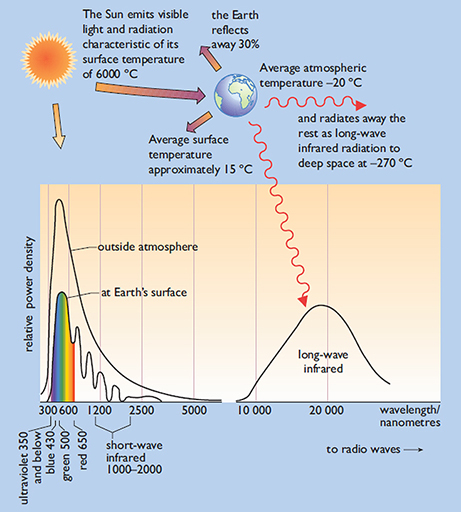1.1 Solar radiation
The Sun is an enormous nuclear fusion reactor, in which at very high temperature hydrogen atoms fuse to form helium at the rate of 4 million tonnes per second. This fusion reaction causes the Sun to radiate energy, due to the resulting high surface temperature (around 6000 °C).
A very small proportion of the Sun’s radiated energy reaches the Earth, 150 million kilometres away, and if you look at Figure 1 you will see that approximately one-third of it is simply reflected back to space. You will also see that the rest is absorbed by the planet and eventually re-transmitted to space as long-wave infrared radiation.
On average, the Earth re-radiates as much energy as it receives and sits in a stable energy balance at a temperature suitable for life.

As Figure 1 shows, solar radiation spreads over a wide spectrum of wavelengths - from ultraviolet light (shorter wavelength than visible violet light) to ‘short-wave’ infrared light (longer wavelength than visible red light). This wavelength distribution is determined by the surface temperature of the Sun.
Earth temperature and solar collection
The Earth has an average atmospheric temperature of –20 °C and a surface temperature of 15 °C. It re-radiates energy as long-wave infrared to deep space, the temperature of which is only a few degrees above absolute zero, –273 °C.
Activity 1 Collection of solar energy
How is solar energy collected differently at low or high temperatures?
Answer
Low-temperature solar energy collection mainly depends on using glass and other surfaces with selective properties that allow solar radiation to pass through but block the re-radiation of long-wave infrared. Glass is transparent to visible light and short-wave infrared radiation, but is opaque to long-wave infrared re-radiated from a solar collector or building behind it.
Over recent decades enormous effort has been put into improving the performance of glazing, both to increase its transparency to visible radiation, and to prevent heat escaping through it.
Gathering solar energy for high-temperature applications, such as driving steam engines to power electricity generators, mainly involves concentrating the Sun’s energy using complex mirrors, as you will see in Section 2.9
You will now go on to discuss direct and diffuse solar radiation.
